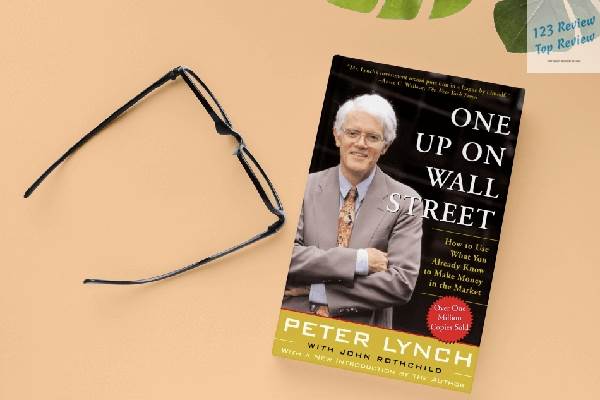Peter Lynch, who managed the Fidelity Magellan Fund with astounding success, outlines his investment philosophy and provides readers with the tools needed to navigate the stock market confidently.
In this article, 123 Review expands on the key concepts, strategies, and applications presented in the One Up on Wall Street book, offering a detailed roadmap for both novice and experienced investors aiming to enhance their investment prowess.
Main Concepts of the Book
Investment Philosophy
At the core of Lynch’s investment philosophy is the belief that the average investor has a unique advantage over professional fund managers. He argues that ordinary people can identify successful investment opportunities by simply observing the products and services they encounter in their daily lives. Lynch famously coined the phrase “invest in what you know,” encouraging individuals to leverage their personal experiences and insights when selecting stocks.

This philosophy empowers investors to trust their instincts and knowledge. Lynch believes that by focusing on industries and companies they are familiar with, individual investors can often spot trends and opportunities before Wall Street catches on. This approach not only makes investing more accessible but also more intuitive, as it builds on the idea that anyone can be a successful investor with the right mindset and approach.
Investment Mindset
Lynch emphasizes the importance of maintaining a disciplined and patient investment mindset. According to him, one of the biggest challenges investors face is managing their emotions, particularly in response to market fluctuations. He warns against the temptation to react impulsively to short-term market movements, which can lead to poor decision-making and unnecessary losses.
Instead, Lynch advocates for a long-term perspective. He advises investors to remain calm and rational, even in the face of market volatility. This patience is crucial because the stock market can be unpredictable in the short term, but over the long term, it tends to reward those who hold onto quality investments. Lynch’s approach is grounded in the belief that time, more than timing, is the key to successful investing.
Importance of Research
Thorough research is a cornerstone of Lynch’s investment strategy. He believes that investors should conduct in-depth research before purchasing any stock, a process that involves understanding a company’s business model, financial health, competitive position, and growth prospects. Lynch argues that this research enables investors to make informed decisions and increases the likelihood of selecting winning stocks.
Lynch also stresses the importance of “doing your homework” when it comes to understanding a company’s fundamentals. He encourages investors to read financial statements, analyze industry trends, and assess the company’s management team. By gathering and analyzing this information, investors can develop a well-rounded view of the company and its potential for future growth. This methodical approach to research helps to reduce risk and improve the chances of making profitable investments.
Stock Selection Strategies
Identifying Winning Stocks
One of Lynch’s key insights is that successful stock picking is about finding companies that are undervalued but have strong potential for growth. He suggests that investors look for companies with a solid track record, competent management, and a clear plan for future expansion. These factors, according to Lynch, are indicative of a company’s ability to generate sustained earnings growth, which in turn drives stock price appreciation.
Lynch also emphasizes the importance of understanding a company’s earnings, which he views as a critical indicator of its financial health and growth potential. He advises investors to focus on companies with consistent and robust earnings growth, as these companies are more likely to see their stock prices rise over time. Additionally, Lynch encourages investors to consider a company’s price-to-earnings (P/E) ratio in the context of its growth rate, a concept he refers to as the PEG ratio. This ratio helps investors determine whether a stock is fairly valued relative to its earnings growth.
Categories of Stocks
In “One Up on Wall Street,” Lynch categorizes stocks into six distinct types, each requiring a different investment strategy:
- Slow Growers: These are mature companies with low growth rates, typically paying substantial dividends. Lynch suggests that these stocks are best suited for conservative investors seeking stability and income rather than high returns.
- Stalwarts: Stalwarts are large, established companies with moderate but consistent growth. These stocks offer a balance of risk and reward, providing steady returns without the volatility of higher-growth stocks. Lynch recommends Stalwarts for investors looking for dependable performers.
- Fast Growers: These are smaller companies with rapid earnings growth, often in the early stages of their development. While Fast Growers offer the highest potential for significant returns, they also come with increased risk. Lynch advises investors to thoroughly research these companies to ensure their growth is sustainable.
- Cyclicals: Cyclical stocks are companies whose performance is closely tied to the economic cycle. Their earnings fluctuate based on economic conditions, making them more volatile. Lynch suggests that investors time their investments in cyclicals carefully, buying when the economy is at a low point and selling when it peaks.
- Turnarounds: Turnaround stocks are companies that have fallen on hard times but have the potential to recover. These stocks can offer substantial rewards if the company successfully turns its fortunes around. However, they also carry significant risk, as not all turnarounds succeed. Lynch advises caution and thorough research when investing in these stocks.
- Asset Plays: Asset plays are companies that possess valuable assets not fully reflected in their stock price. These assets could include real estate, patents, or cash reserves. Lynch encourages investors to look for companies where these hidden assets provide a margin of safety, reducing downside risk while offering potential upside.
By categorizing stocks in this way, Lynch provides a framework that helps investors tailor their strategies to different types of companies, maximizing their chances of success.
Evaluating Companies
Lynch’s approach to evaluating companies goes beyond just the financial metrics. While he acknowledges the importance of numbers like the P/E ratio and earnings per share (EPS), he also stresses the significance of understanding a company’s “story.” This means considering qualitative factors such as the company’s competitive advantages, market position, management quality, and future growth prospects.
Lynch encourages investors to ask critical questions: What makes this company unique? How does it compare to its competitors? What are its growth drivers? By understanding the narrative behind the numbers, investors can better assess whether a company has the potential to succeed in the long term. This holistic approach to evaluation helps investors identify not just good stocks, but great companies with sustainable competitive advantages.
Tenbaggers
Characteristics of Tenbaggers
One of Lynch’s most famous concepts is the “tenbagger,” a stock that appreciates tenfold in value. Identifying tenbaggers is the holy grail of investing, as these stocks can dramatically increase the value of a portfolio. According to Lynch, tenbaggers typically share several key characteristics:
- Strong Earnings Growth: Tenbaggers are usually companies that have consistently strong earnings growth, driven by a solid business model and effective management.
- Small Market Capitalization: These companies are often small-cap stocks, which have more room to grow compared to larger, more established companies.
- Under the Radar: Tenbaggers are frequently overlooked by Wall Street, allowing savvy individual investors to spot them before they gain widespread attention.
- Compelling Story: A tenbagger often has a compelling narrative, such as a breakthrough product, a rapidly expanding market, or a significant competitive advantage.
Identifying Potential Tenbaggers
Lynch believes that identifying potential tenbaggers requires a combination of research, patience, and an eye for emerging trends. He advises investors to focus on small companies that are leaders in niche markets or are poised to capitalize on industry shifts. These companies often fly under the radar of institutional investors, providing individual investors with a unique opportunity to get in early.
Lynch also suggests looking for companies with strong insider ownership, as this indicates that the management team is confident in the company’s future. Insider buying is often a positive signal, suggesting that those with the most knowledge of the company believe in its potential. Additionally, Lynch recommends paying attention to a company’s earnings growth, as sustained earnings increases are often a precursor to significant stock price appreciation.
Common Investor Pitfalls
Mistakes to Avoid
Lynch outlines several common mistakes that investors should avoid to improve their chances of success:
- Over-Diversification: While diversification is important, Lynch warns against over-diversifying, which can dilute the impact of your best ideas. He suggests that investors should focus on a smaller number of well-researched stocks rather than spreading themselves too thin across many investments.
- Chasing Hot Stocks: Lynch cautions against chasing the latest hot stock or fad. He believes that by the time a stock becomes widely popular, much of its growth potential may have already been realized. Instead, investors should focus on finding undervalued stocks with strong fundamentals.
- Trying to Time the Market: Lynch is a strong advocate of staying invested for the long term rather than trying to time the market. He argues that even the most experienced investors struggle to predict short-term market movements consistently, and attempts to time the market often lead to missed opportunities.
- Panic Selling: Emotional reactions to market downturns can lead to panic selling, which Lynch considers one of the biggest mistakes an investor can make. He advises staying the course during market corrections, as long as the underlying fundamentals of your investments remain strong.
Understanding Market Trends
Lynch emphasizes the importance of understanding broader market trends, but he cautions against letting them dictate investment decisions. He argues that while it’s important to be aware of economic cycles and industry trends, investors should focus on the fundamentals of individual companies rather than trying to predict short-term market movements.
Lynch also warns against being swayed by market hype or fear. He advises investors to remain disciplined and to base their decisions on careful analysis rather than emotions. By maintaining a focus on the long-term prospects of the companies they invest in, investors can avoid the pitfalls of short-term thinking and market speculation.
Long-term Investment Strategies
Building a Stock Portfolio
Building a successful stock portfolio requires careful planning and a clear understanding of one’s investment goals and risk tolerance. Lynch advises investors to diversify their portfolios across different types of stocks, including growth stocks, defensive stocks, and income-producing stocks. This diversification helps to balance risk and reward, providing stability while also offering opportunities for growth.
Lynch also emphasizes the importance of regularly reviewing and adjusting your portfolio. As market conditions change and companies evolve, investors should reassess their holdings to ensure they still align with their investment objectives. This ongoing evaluation allows investors to stay ahead of potential risks and capitalize on new opportunities.
The Role of Patience in Investing
Patience is a recurring theme in Lynch’s investment philosophy. He believes that successful investing requires a long-term perspective and the ability to weather short-term market volatility. Lynch advises investors to hold onto quality stocks even during market downturns, as long as the underlying business fundamentals remain strong.
Lynch’s mantra, “time is on your side when you own shares of superior companies,” underscores the importance of patience in achieving long-term investment success. By resisting the urge to react impulsively to short-term market movements, investors can give their investments the time needed to grow and compound, ultimately leading to significant wealth accumulation.
Practical Applications
Real-World Examples
Lynch illustrates his investment principles with numerous real-world examples throughout “One Up on Wall Street.” For instance, he discusses how he identified successful investments like Dunkin’ Donuts and Hanes by observing consumer behavior and conducting thorough research. These examples demonstrate how ordinary investors can apply Lynch’s principles to find winning stocks in their own lives.
Lynch’s approach to investing is rooted in practicality. He encourages investors to look for investment opportunities in their everyday experiences, such as noticing when a new product becomes popular or when a particular company’s services are in high demand. By staying attuned to the world around them, investors can identify potential investments that others might overlook.
Using Knowledge to Invest
Lynch empowers investors to use their knowledge and insights to make informed investment decisions. He believes that by staying informed about the industries and companies they are familiar with, investors can identify opportunities that others might miss. This approach allows investors to leverage their unique perspectives and experiences in the stock market, turning their everyday observations into profitable investments.
Lynch also encourages investors to continually expand their knowledge and stay curious. He advises reading extensively, keeping up with industry news, and learning from both successes and failures. This commitment to lifelong learning not only enhances an investor’s ability to make informed decisions but also helps them adapt to changing market conditions and seize new opportunities as they arise.
Conclusion of Key Principles
Recap of Investment Techniques
“One Up on Wall Street” offers a wealth of investment techniques that emphasize research, patience, and a focus on long-term growth. Lynch’s advice to invest in what you know, identify potential tenbaggers, and avoid common investor pitfalls provides a solid foundation for successful investing. His emphasis on understanding a company’s story, maintaining a disciplined mindset, and building a diversified portfolio are key takeaways that can help investors navigate the complexities of the stock market.
Future of Investing Based on Lynch’s Principles
The principles outlined by Lynch remain as relevant today as they were when “One Up on Wall Street” was first published. As technology and globalization continue to reshape industries, the ability to identify emerging trends and invest in quality companies will be crucial. Lynch’s approach to investing, which combines common sense, rigorous research, and a long-term perspective, provides a timeless framework that can help investors succeed in an ever-changing market.
By adhering to Lynch’s principles, investors can position themselves for long-term success in the stock market. His emphasis on patience, discipline, and thorough research offers a roadmap for navigating the challenges and opportunities that lie ahead. In an increasingly complex financial landscape, the wisdom and insights shared in “One Up on Wall Street” continue to serve as a valuable guide for investors seeking to build wealth and achieve their financial goals.
In conclusion, Peter Lynch’s “One Up on Wall Street” is a treasure trove of wisdom for investors. Whether you are a novice looking to learn the basics or an experienced investor seeking to refine your strategy, the principles outlined in this book provide a solid foundation for achieving long-term success in the stock market. By following Lynch’s advice, anyone can improve their investment strategy, avoid common mistakes, and ultimately achieve financial success.





